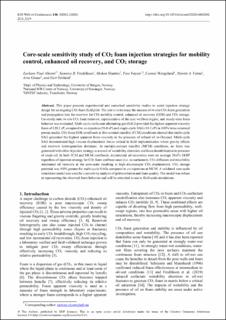| dc.contributor.author | Alcorn, Zachary Paul | |
| dc.contributor.author | Fredriksen, Sunniva | |
| dc.contributor.author | Sharma, Mohan | |
| dc.contributor.author | Føyen, Tore Lyngås | |
| dc.contributor.author | Wergeland, Connie | |
| dc.contributor.author | Fernø, Martin | |
| dc.contributor.author | Graue, Arne | |
| dc.contributor.author | Ersland, Geir | |
| dc.date.accessioned | 2020-06-12T08:38:44Z | |
| dc.date.available | 2020-06-12T08:38:44Z | |
| dc.date.created | 2019-12-11T14:05:46Z | |
| dc.date.issued | 2020 | |
| dc.identifier.citation | E3S Web of Conferences. 2020, 146 1-12. | en_US |
| dc.identifier.issn | 2267-1242 | |
| dc.identifier.uri | https://hdl.handle.net/11250/2657845 | |
| dc.description.abstract | This paper presents experimental and numerical sensitivity studies to assist injection strategy design for an ongoing CO2 foam field pilot. The aim is to increase the success of in-situ CO2 foam generation and propagation into the reservoir for CO2 mobility control, enhanced oil recovery (EOR) and CO2 storage. Un-steady state in-situ CO2 foam behavior, representative of the near wellbore region, and steady-state foam behavior was evaluated. Multi-cycle surfactant-alternating gas (SAG) provided the highest apparent viscosity foam of 120.2 cP, compared to co-injection (56.0 cP) and single-cycle SAG (18.2 cP) in 100% brine saturated porous media. CO2 foam EOR corefloods at first-contact miscible (FCM) conditions showed that multi-cycle SAG generated the highest apparent foam viscosity in the presence of refined oil (n-Decane). Multi-cycle SAG demonstrated high viscous displacement forces critical in field implementation where gravity effects and reservoir heterogeneities dominate. At multiple-contact miscible (MCM) conditions, no foam was generated with either injection strategy as a result of wettability alteration and foam destabilization in presence of crude oil. In both FCM and MCM corefloods, incremental oil recoveries were on average 30.6% OOIP regardless of injection strategy for CO2 foam and base cases (i.e. no surfactant). CO2 diffusion and miscibility dominated oil recovery at the core-scale resulting in high microscopic CO2 displacement. CO2 storage potential was 9.0% greater for multi-cycle SAGs compared to co-injections at MCM. A validated core-scale simulation model was used for a sensitivity analysis of grid resolution and foam quality. The model was robust in representing the observed foam behavior and will be extended to use in field scale simulations. | en_US |
| dc.language.iso | eng | en_US |
| dc.publisher | EDP Sciences | en_US |
| dc.rights | Navngivelse 4.0 Internasjonal | * |
| dc.rights.uri | http://creativecommons.org/licenses/by/4.0/deed.no | * |
| dc.subject | Injection strategies | en_US |
| dc.subject | CO2 storage | en_US |
| dc.title | Core-scale sensitivity study of CO2 foam injection strategies for mobility control, enhanced oil recovery, and CO2 storage | en_US |
| dc.type | Journal article | en_US |
| dc.type | Peer reviewed | en_US |
| dc.description.version | publishedVersion | en_US |
| dc.rights.holder | © The Authors, published by EDP Sciences, 2020. This is an Open Access article distributed under the terms of the Creative Commons Attribution License 4.0, which permits unrestricted use, distribution, and reproduction in any medium, provided the original work is properly cited. | en_US |
| dc.source.pagenumber | 1-12 | en_US |
| dc.source.volume | 146 | en_US |
| dc.source.journal | E3S Web of Conferences | en_US |
| dc.identifier.doi | 10.1051/e3sconf/202014602002 | |
| dc.identifier.cristin | 1759352 | |
| dc.relation.project | Norges forskningsråd: 249742 | en_US |
| cristin.ispublished | true | |
| cristin.fulltext | original | |
| cristin.qualitycode | 1 | |

